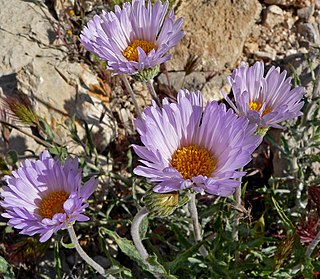
Xylorhiza is a genus of flowering plants in the family Asteraceae, known as woodyasters. These are daisylike wildflowers usually having blue to purple or white ray flowers with yellow centers of disc florets. Woodyasters are native to western North America.

Allium tuolumnense is a rare species of wild onion, known by the common name Rawhide Hill onion.

Agoseris glauca is a species of flowering plant in the family Asteraceae known by the common names false dandelion, pale agoseris, prairie agoseris, and short-beaked agoseris. It is native to western North America.
Brodiaea orcuttii is a species of flowering plant in the family Asparagaceae, subfamily Brodiaeoideae. It is a cluster-lily known by the common name Orcutt's brodiaea. The bulb is native to Southern California, mainly San Diego County, where it is an uncommon species. Its range probably extends into Baja California.
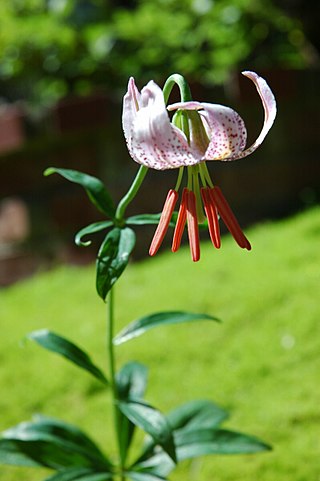
Lilium kelloggii is a species of lily known by the common name Kellogg's lily. It is endemic to the Klamath Mountains of northwestern California and southwestern Oregon, where it grows in forests, including those dominated by redwoods.

Lilium maritimum is a species of lily known by the common name coast lily. It is endemic to California, where it is known only from the coastline north of San Francisco. It formerly occurred south of San Francisco, but these occurrences have all been extirpated. The species is now restricted to the North Coast from Marin County to Del Norte County, and is most common in Mendocino County. It grows in the California coastal prairie habitat, coniferous forests, and bogs amongst Drosera species.

Lilium rubescens is an uncommon species of lily known by the common names redwood lily and chaparral lily. It is native to northwestern California and southwestern Oregon, where it is known from the Coast Ranges from Lane County to Santa Cruz Counties.
Linanthus orcuttii is an uncommon species of flowering plant in the phlox family known by the common name Orcutt's linanthus. It is known only from southern California and Baja California, where it grows in chaparral and pine forests in the Peninsular Ranges and occasionally the San Bernardino Mountains.
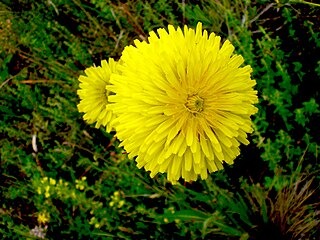
Microseris laciniata is a species of flowering plant in the family Asteraceae known by the common name cutleaf silverpuffs. It is native to the western United States from Washington to northern California and Nevada, where it grows in forest and grassland habitat.
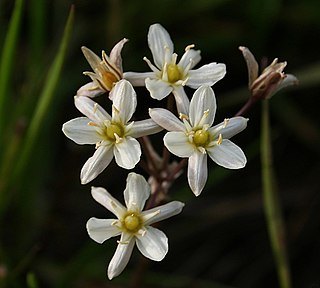
Muilla maritima is a species of flowering plant known by the common names sea muilla and common muilla. It is native to California and Baja California, where it grows in many types of habitats from the coast to the Mojave Desert and Sierra Nevada foothills and other inland mountains, in grassland, woodland, desert, and forest floras. It is a perennial plant growing from a corm and producing an erect flowering stem up to half a meter tall. The onion-like leaves at the base of the stem may be 60 centimeters long. The flowering stem bears an umbel-shaped array of many flowers on pedicels up to 5 centimeters long. Each flower has six tepals which are green-tinged white in color with brownish midribs and no more than 6 millimeters in length. At the center of the flower are six erect stamens with blue, green, or purplish anthers.
Schinia jaegeri is a moth of the family Noctuidae. It is found in southern California and northern Baja California.

Penstemon spectabilis is a species of penstemon known by the common name showy penstemon or showy beardtongue. It is native to southern California and Baja California, where it grows in the chaparral, scrub, and woodlands of the coastal mountain ranges.

Pyrrocoma apargioides is a species of flowering plant in the family Asteraceae known by the common name alpineflames. It is native to the western United States from the Sierra Nevada of California east to Utah, where it grows in the forests and meadows of high mountains. It is a perennial herb growing from a taproot and producing one or more stems to 30 centimeters in length. The stems are decumbent or upright, reddish, and hairless to slightly woolly. Most of the leaves are located around the base. They are thick and leathery, lance-shaped with large sawteeth along the edges, often center-striped in white, and measure up to 10 centimeters long. The inflorescence is usually a single flower head lined with centimeter-long phyllaries which are reddish to green with red edges. The head has a center of yellow disc florets and a fringe of ray florets which are yellow, often splashed with red along the undersides, measuring up to 1.6 centimeters in length. The fruit is an achene which may be well over a centimeter in length including its pappus.

Pyrrocoma carthamoides is a species of flowering plant in the family Asteraceae known by the common name largeflower goldenweed. It is native to western North America from British Columbia to northeastern California to Wyoming, where it is known from grassland, woodlands, forests, barren areas, and other habitat. It is a perennial herb growing from a taproot and producing one or more stems to about half a meter in maximum length, the stems reddish-green and leafy. The largest leaves are at the base of the stem, measuring up to 20 centimeters long, lance-shaped with spiny sawtoothed edges. Leaves higher on the stem are smaller and hairier. The inflorescence is a single flower head or a cluster of up to four. Each bell-shaped head is lined with phyllaries each up to 2 centimeters long. It has many yellow disc florets surrounded by a fringe of yellow ray florets up to 7 millimeters long; ray florets are occasionally absent. The fruit is an achene which may be well over a centimeter in length including its pappus.
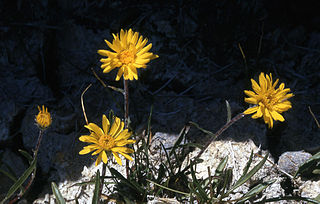
Pyrrocoma uniflora is a species of flowering plant in the family Asteraceae known by the common name plantain goldenweed. It is native to western North America from central Canada to California to Colorado, where it grows in several types of habitat, including forest and meadows with alkali soils, such as those near hot springs. It is a perennial herb growing up to 40 centimeters tall, the stems reddish and usually with a thin to thick coating of woolly fibers. The lance-shaped, toothed leaves are usually woolly, the largest near the base of the plant reaching up to 12 centimeters in length. The inflorescence is a single flower head or a cluster of a few heads, each lined with woolly phyllaries. The head contains yellow disc and ray florets. The fruit is an achene which may be over a centimeter long including its long pappus.

Raillardella pringlei is an uncommon species of flowering plant in the family Asteraceae known by the common name showy raillardella.
Tripterocalyx crux-maltae is a species of flowering plant in the four o'clock family known by the common names Lassen sandverbena and Kellogg's sand-verbena.
Xylorhiza cognata is a rare species of flowering plant in the family Asteraceae known by the common names Mecca-aster and Mecca woodyaster.
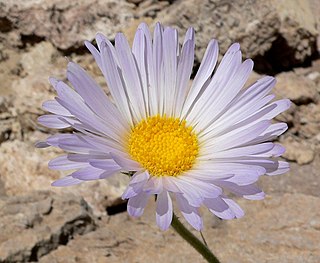
Xylorhiza tortifolia is a species of flowering plant in the family Asteraceae, known by the common names Mojave-aster and Mojave woodyaster.
Hazardia orcuttii is a rare North American species of flowering plant in the family Asteraceae known by the common names Orcutt's bristleweed and Orcutt's goldenbush. It is native to California in the United States and Baja California in Mexico. It can be found in one location in California, in the city of Encinitas. There, it is located in and near a protected zone known as the Manchester Conservation Area. In Baja California it can be found at 11 to 17 locations.














